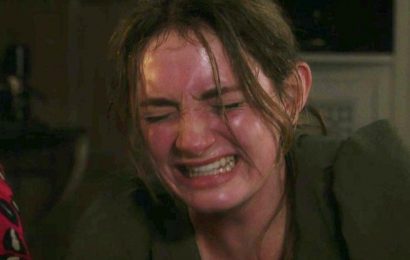(Welcome to The Quarantine Stream, a new series where the /Film team shares what they’ve been watching while social distancing during the COVID-19 pandemic.)
The Movie: On-Gaku: Our Sound
Where You Can Stream It: Available on PVOD
The Pitch: Three high school delinquents who spend their days playing video games when they’re not casually beating up the gangs from rival schools suddenly decide to start a rock ‘n’ roll band — despite having no skills, no money, and no equipment except for two stolen bass guitars and half a drum set.
Why It’s Essential Viewing: The debut film of director Kenji Iwaisawa, On-Gaku: Our Sound looks like no other anime movie. Or, indeed, like any other animated movie right now. Using a combination of rotoscoping (traced animation of live-action footage) and a cartoonishly simple hand-drawn art style that looks like it came out of a newspaper strip, On-Gaku: Our Sound is an oddball musical comedy that looks as irreverent as it feels — a truly weird, and disarmingly sweet, paean to the art of rock ‘n’ roll.
Based on the manga by Hiroyuki Ohashi, On-Gaku: Our Sound became a bit of a dark horse in the anime world when it beat out I Lost My Body and Children of the Sea for the Grand Prix at the Ottawa Animation Festival in September 2019. What was this strange little anime film, which eschewed the traditional art style of Japanese animation in favor of minimalist caricatures — a couple of brush strokes away from stick figures — who move so smoothly against the abstract, brightly penciled in backgrounds?
A passion project concocted over 7 years by creator Hiroyuki Ohashi, documentary filmmaker Tetsuaki Matsue, and director Iwaisawa, On-Gaku (which simply means “music” in Japanese) began as self-published cult manga in 2005. In 2012, Ohashi started a crowdfunding campaign to help make the animation, with Matsue, a known buff of Japanese underground music, producing. Every frame of the film was meticulously animated by Iwaisawa, who drew over 40,000 pictures on his own over the course of 7 years. The result is a slim 71-minute feature whose minimalist art style, uncannily realistic movement, and hilariously deadpan characters shatter the rules of Japanese animation.
On a story level, On-Gaku is very simple, maybe absurdly so. The film follows Kenji (voiced by alternative rocker Shintaro Sakamoto), Asakura (voiced by Tateto Serizawa) and Ota (voiced by Tomoya Maeno), three lunkheaded classmates at Chiku High in the small town of Sakamoto who have been ironically dubbed “The Three Musketeers” for their fearsome reputation among other high school gangs. When they’re not picking fights or bullying others, they’re playing retro computer games or sluggishly hanging out in an empty classroom, their chats between each other amounting to no more than a few grunts or monosyllabic responses.
One day, Kenji finds himself in possession of an electric bass guitar (well, he steals it) from which curious inspiration strikes. He wants to form a band, he suddenly tells his two friends the next day. They steal another bass and half a drum set from the school music room, and set it up in Kenji’s room with no idea what to do next. Immediately, they launch into a rhythmic barrage of wordless noise, playing like this for a full minute before stopping and agreeing that they have created something wonderful. Their bumbling attempts to start a band, which they name “Kobujitsu” (ancient martial arts), puts them in contact with another folky school band “Kobijitsu” (ancient fine arts), with whom they strike up an unlikely friendship after Kobijitsu’s frontman Morita (voiced by actress Kami Hiraiwa) proclaim them to be rock music prodigies and invites them to play at the town’s annual rock festival.
From there on, On-Gaku unfolds in the most unexpected ways. There’s no heartwarming lesson to be learned, the rival gangsters who hover on the fringes are no more than comedic relief, and our weirdo protagonist Kenji just loses all interest in music halfway through the film. But even as the story devolves in strange ways, so does the artwork evolve into a trippy flight of fancy — the characters transported to surreal fantasy worlds when they reach musical revelations, or transformed into psychedelic pencil drawings through the rotoscoping of feverish footage from real Japanese bands Galaxiedead, Oshiripenpenz and other singers. Rotoscoping is both an underused and overused technique — the former in ways that actually complement traditional art style, and the latter when filmmakers try too hard to “experiment.” Not since the famous “God Knows” sequence in Kyoto Animation’s The Melancholy of Haruhi Suzumiya has rotoscoping been used in anime to such exciting effect, not only for the wild music sequences but to add that uncanny level of reality to the movement of comic strip characters.
It all adds to the film’s almost hypnotic weirdness — a tableau of abstract images with the occasional splash of wild, energetic color.
The On-Gaku: Our Sound Blu-ray/ DVD is also available from GKIDS be purchased here .
Source: Read Full Article








